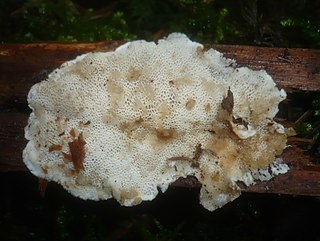
The Tremellomycetes are a class of dimorphic fungi in the Agaricomycotina. Some species have gelatinous basidiocarps or (microscopically) a sacculate parenthesome. There are six orders, 17 families, and 39 genera in the Tremellomycetes. Tremellomycetes include yeasts, dimorphic taxa, and species that form complex fruiting bodies. Tremellomycetes include some fungi that are human and animal pathogens in the genera Cryptococcus, Naganishia, Papiliotrema, and Trichosporon and some fungi that are cultivated for food in the genera Tremella and Naematelia.
The Cystofilobasidiales are an order of fungi in the class Tremellomycetes of the Basidiomycota. They usually exhibit a life phase of free-living yeasts. The order contains two families with seven genera and some 25 species.
The Filobasidiales are an order in the fungal class Tremellomycetes. The order contains two families and seven genera.

The Tremellales are an order of fungi in the class Tremellomycetes. The order contains both teleomorphic and anamorphic species, most of the latter being yeasts. All teleomorphic species in the Tremellales are parasites of other fungi, though the yeast states are widespread and not restricted to hosts. Basidiocarps, when produced, are gelatinous.
The Cuniculitremaceae are a family of fungi in the order Tremellales. There are three genera in the family. Sterigmatosporidium polymorphum parasitizes other fungi growing in insect galleries in wood. It does not produce basidiocarps, but has septate basidia similar to those found in the genus Tremella. Most species are known only from their yeast states.

Tremella is a genus of fungi in the family Tremellaceae. All Tremella species are parasites of other fungi and most produce anamorphic yeast states. Basidiocarps, when produced, are gelatinous and are colloquially classed among the "jelly fungi". Over 100 species of Tremella are currently recognized worldwide. One species, Tremella fuciformis, is commercially cultivated for food.

Phaeotremella foliacea is a species of fungus in the family Phaeotremellaceae. It produces brownish, frondose, gelatinous basidiocarps and is parasitic on the mycelium of Stereum sanguinolentum, a fungus that grows on dead attached and recently fallen branches of conifers. It is widespread in north temperate regions. In the UK it has the recommended English name leafy brain and has also been called jelly leaf and brown witch's butter. Prior to 2017, the name Tremella foliacea was also applied to similar-looking species on broadleaf trees, now distinguished as Phaeotremella frondosa and Phaeotremella fimbriata.
The Mrakiaceae are a family of fungi in the order Cystofilobasidiales. Phylogenetic analyses shows that this family is clearly distinct from other yeast-like families of the Tremellomycetes. The family had six genera in 2015.
The Holtermanniales are an order in the fungal class Tremellomycetes. The order contains two genera. Species of Holtermannia produce groups of horn-like gelatinous basidiocarps on wood and have associated yeast states. Species of Holtermaniella are only known as yeasts.
Naganishia is a genus of fungi in the family Filobasidiaceae. Species are currently only known from their yeast states, most of which were formerly referred to the genus Cryptococcus. Some 15 species have been described worldwide. Naganishia albida is an occasional human pathogen.
Naganishia adeliensis is a species of fungus in the family Filobasidiaceae. It is currently only known from its yeast state, isolated from decaying algae in Antarctica.
Solicoccozyma is a genus of fungi in the family Piskurozymaceae. Species have only been isolated in their yeast states, several of which were formerly referred to the genus Cryptococcus, but can produce filamentous states with basidia in culture. Nine species have been described worldwide.
The Rhynchogastremaceae are a family of fungi in the order Tremellales. The family currently contains two genera. Some species produce filamentous sexual states with septate basidia and are parasites of other fungi. Most, however, are only known from their yeast states.
The Trichosporonaceae are a family of fungi in the order Trichosporonales. The family currently contains six genera. Species are not known to produce basidiocarps, but exist as yeasts or produce septate hyphae with arthroconidia. Several species are human pathogens.
The Trichosporonales are an order in the fungal class Tremellomycetes. The order contains two families and ten genera. Several species in the Trichosporonaceae are human pathogens.
The Tetragoniomycetaceae are a family of fungi in the order Trichosporonales. The family currently contains four genera. Several species are only known from their yeast states.

The Carcinomycetaceae are a family of fungi in the order Tremellales. The family currently contains a single genus. Some species produce filamentous sexual states with basidia and are parasites of other fungi. Some, however, are only known from their yeast states.
The Spiculogloeomycetes are a class of fungi in the subdivision Pucciniomycotina of the Basidiomycota. The class consists of a single order, the Spiculogloeales, together with an additional, unassigned genus, Meniscomyces. Many species are currently known only from their yeast states. Species in the genus Spiculogloea form hyphal states that produce auricularioid basidia and are parasitic on other fungi.

Carcinomyces is a genus of fungi in the order Tremellales. Species are parasites of other fungi and produce anamorphic yeast states. Four species of Carcinomyces are recognized worldwide. The generic placement of a fifth species, Carcinomyces mycetophilus, is currently uncertain.
Pseudotremella moriformis is a species of fungus in the family Bulleraceae. It produces dark purple, pustular, gelatinous basidiocarps and is parasitic on pyrenomycetous fungi on dead herbaceous stems and wood. It was originally described from England.






